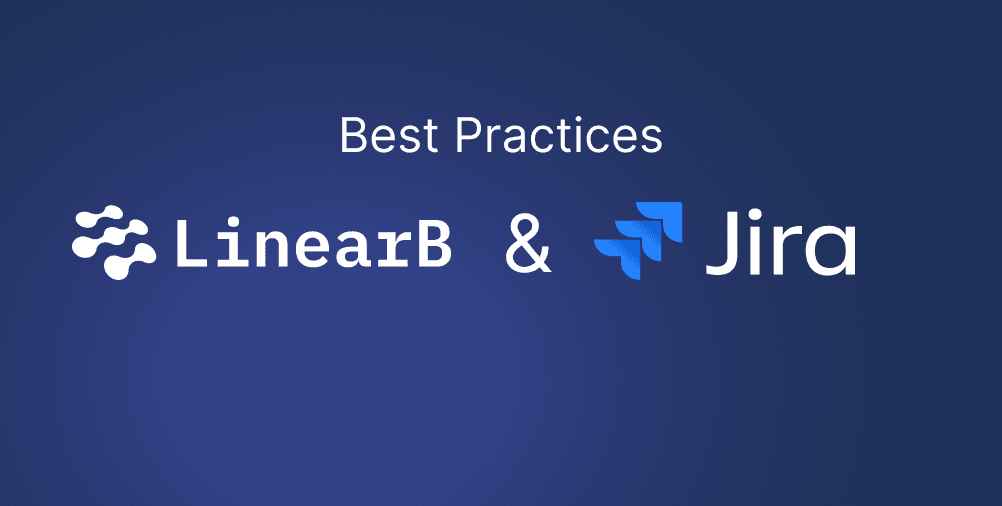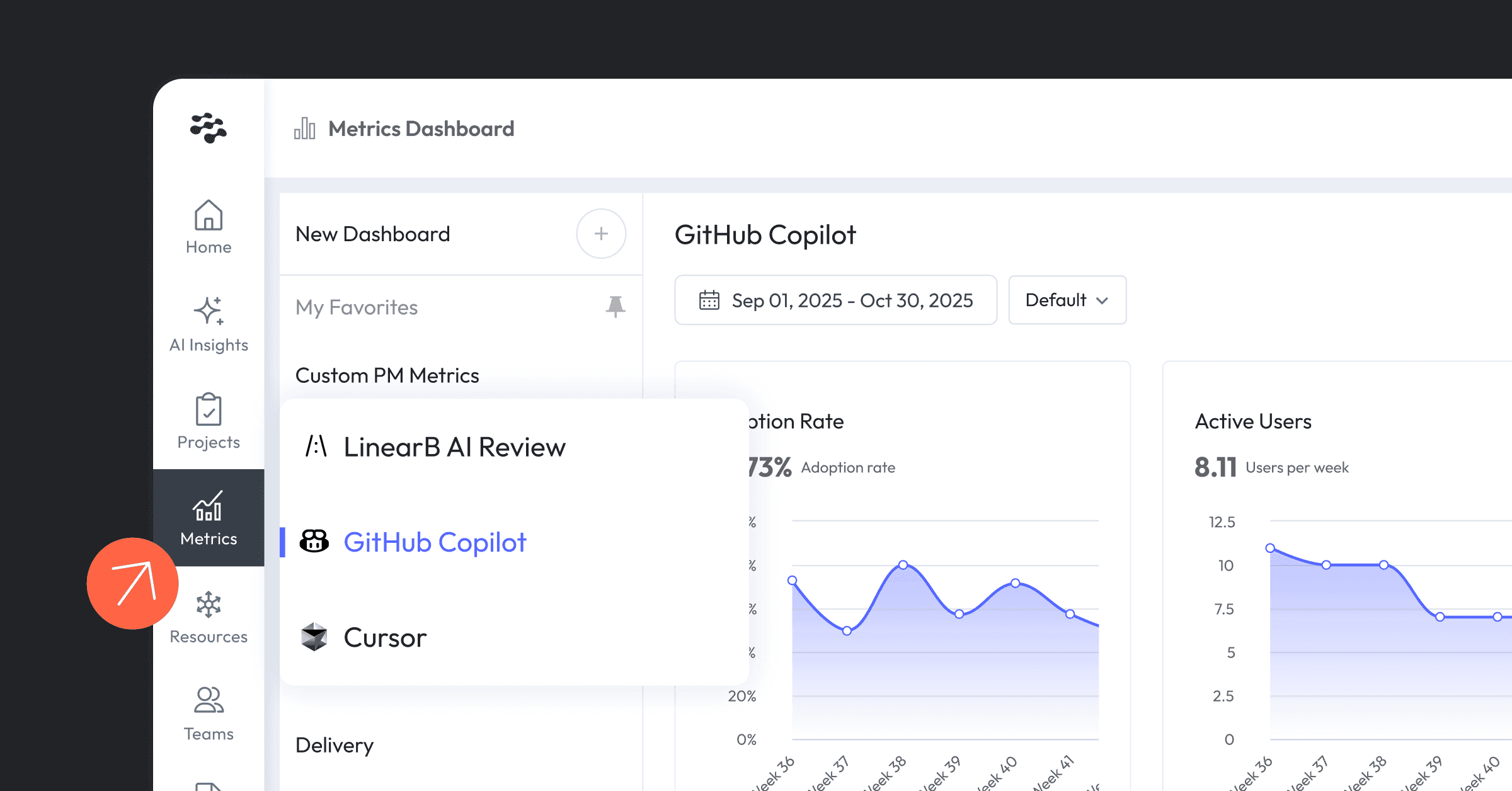Integrating Jira with LinearB presents an opportunity for software development teams to streamline project delivery and enhance productivity. This document outlines essential best practices for optimizing this integration, covering key aspects of project organization, issue tracking, resource allocation, and incident management.
By leveraging LinearB's advanced analytics and automation capabilities alongside Jira's project management features, teams can gain deeper insights into their development processes and make informed decisions that drive project success.

LinearB Best Practices
As an out-of-the-box tool, LinearB is highly flexible. Most organizations do not need to change their Jira configuration or existing workflows in order to gain the efficiency and productivity benefits the LinearB platform offers. That said, we’ve worked with teams across the world to build a list of Jira best practices that will make your experience using LinearB easier than ever before.
1. Project Organization in LinearB:
Utilizing LinearB projects based on Jira boards is essential for effectively managing software development efforts. Projects in LinearB are based on Jira boards. You can add more than one Jira board to a project, and you can add additional filtering to get only part of the issues from the boards, such as Label, Epic, Fix version, or custom fields.
Pro Tip: Scrum Projects: If you want to track the work of a team or project and see its accuracy over time, it is essential to have the sprints aligned across the boards you used for the projects’ configuration.
Project Investment Profile
Defining clear issue types in Jira is crucial for accurately categorizing and tracking work items. To ensure LinearB’s project investment profile accurately represents your team’s work, make sure issue types represent all types of work you have and want to track:
- User story - smallest work needs to be done to present a change in the product.
- Task/Non-functional story - Work needs to be done. Usually, it is non-functional work such as refactor or infrastructure work.
- Bug - Issue with the product that require a fix
- If you have different types of work you want to track, you can create separate Standard issue types (for example, Automation tasks, Security tasks, Tests, Infra changes)
Project People Effort
Accurate people effort data within LinearB is highly dependent on ensuring all issues are assigned. To ensure a high level of data integrity in your Jira instance, we recommend using the following methods:
- Field configuration - configure the field as mandatory, which will make it required while creating a new issue
- Workflows - during specific transitions (transition to “In progress,” for example), create a validation rule called “Field Required Validator.”
- Component lead can also be set as a default assignee if you are using Jira’s Component field.
- Automation rule - You can create automation to set a default assignee based on a different field (such as Team).
2. Resource Allocation and Investment Profile
Efficient resource allocation is vital for maximizing productivity and achieving project goals. Leveraging LinearB's resource allocation and investment profile features provides valuable insights into where your team's resources are being invested and where you need to prioritize effort.
By associating work items with specific issue types, labels, components, or custom fields, you can accurately track resource utilization across different types of tasks.
One way is to have issue types that represent the actual work (as explained in the PDT section):
- User story - the smallest work needs to be done to present a change in the product.
- Task/Non-functional story - Work that needs to be done. Usually, it is non-functional work such as refactor or infrastructure work.
- Bug - Issue with the product that requires a fix
- If you have different types of work you want to track, you can create separate Standard issue types (for example, Automation tasks, Security tasks, Test, Infra changes)
In addition to issue types, you can have labels, use components, or add custom fields to specify the work being done. For example, add a custom field to represent the roadmap category, revenue driver, and investment type.
- Anything that can be a closed list (select list - single option) can help you get the exact information you need to invest the resources the way you intended.
3. Custom Project Management Metrics
In LinearB, you can create custom dashboards to track specific metrics relevant to your team's goals. Consider metrics such as Defect Escape Bugs, Closing Rate of Stories, or Cycle Time. These metrics provide valuable insights into your team's efficiency, quality of work, and overall productivity. By regularly monitoring custom PM metrics, you can make data-driven decisions to optimize your team's performance.
The following metrics can be configured in any custom dashboard:
Metric Type
Display counts of issues, or the sum of story points assigned to issues.
Scope
Filter which issues this widget displays. Widgets can pull issues for Jira boards, epics, labels, fields, LinearB teams, or combinations. Note that these filters build on each other, meaning if a board and label are selected, LinearB will only display issues in a board that contains the label.
Issue Type
This data is pulled from your Jira instance and can be any issue type built into your instance. Multiple issue types can be selected.
Jira State
- Single Jira State
Collects all issues that were in the selected Jira state at any point in the designated time frame.
Example: Any issue that was set to "in QA" at any time in the day, week, or month displayed.
- Transition between 2 states
Collects all issues which transitioned from one state to the second.
Example: All issues which moved from "in progress" to "In review".
Custom Metrics FAQs
- I see a difference between daily and weekly numbers.
It's very possible that an issue enters a specific state or transitions between two states multiple times in its lifetime. For example, an issue goes between "in progress" and "in review" states two times as a team QAs a ticket. When viewing a monthly breakdown of issues "in progress," this issue will be counted once, as it was in this state during that month. However, if you change a report to view a daily breakdown, this issue will be included in counts on each calendar day the issue was in the "in progress" state.
- What timezone are these reports using?
Days are measured using the UTC timezone.
- I should have more issues in my done issues widget.
The Done filter in these widgets will only count issues that transition to done (and remain in done) on that particular day. If an issue is removed from the done state, it will not be counted.
General Jira Best Practices for Software Development Teams
By following these best practices, your software development team can maximize the benefits of using Jira for project management and collaboration.
Clear Project Organization: Structure Jira projects logically, considering team responsibilities, project scope, and workflow requirements. Use categories like Epics, Stories, Tasks, and Sub-tasks to break down work efficiently.
Customized Workflows: Customize Jira workflows to reflect your team's development process accurately. Ensure workflows are intuitive, streamlined, and aligned with Agile or other methodologies your team follows.
Consistent Issue Tracking: Enforce consistent use of issue types, priorities, and fields across projects. Standardize naming conventions and ensure all team members understand how to categorize and track issues effectively.
Effective Sprint Planning: Utilize Jira boards and Agile features to plan and manage sprints effectively. Use features like backlog grooming, story point estimation, and sprint retrospectives to improve sprint outcomes.
Collaborative Documentation: Encourage collaboration by using Jira for documentation, including requirements, user stories, design specifications, and technical documentation. Link documentation to relevant issues for easy reference.
Transparent Communication: Use Jira comments, mentions, and notifications to facilitate transparent communication among team members. Keep discussions focused and ensure everyone is aware of updates and changes.
Version Control Integration: Integrate Jira with your version control system (e.g., Git) to track code changes and link commits to relevant issues. This improves traceability and facilitates code reviews and debugging.
Automated Testing Integration: Integrate Jira with your automated testing tools (e.g., Jenkins, Selenium) to automate testing workflows and link test results to corresponding issues. This ensures efficient testing and faster issue resolution.
Regular Maintenance and Cleanup: Regularly review and clean up old or outdated issues, workflows, and configurations. This prevents clutter and ensures Jira remains efficient and relevant to your team's current needs.
Continuous Improvement: Foster a culture of continuous improvement by regularly soliciting feedback from team members on Jira usage. Identify areas for improvement and implement changes to optimize your team's workflow and productivity.
Implementing these best practices can streamline Jira usage, improve development processes, and enhance engineering operations. By adding structure, consistency, and classification to Jira instances, teams can achieve better results in their software development endeavors.




